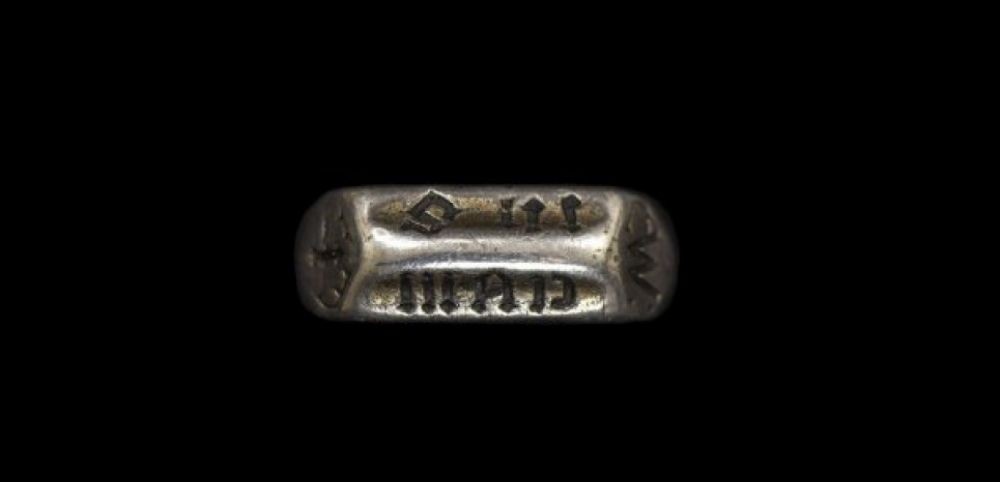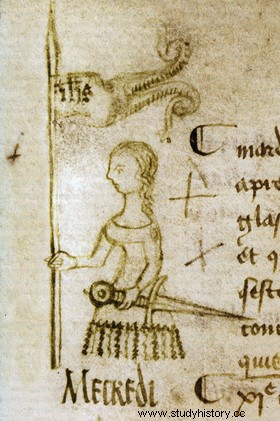 The supposed ring of Joan of Arc sold in February in London by Timeline Auctions.
The supposed ring of Joan of Arc sold in February in London by Timeline Auctions. RING. After being welcomed with fanfare on Sunday March 20, 2016 at Puy-du-Fou, which acquired it, the supposed ring of Joan of Arc may well have to return to England. Indeed, the ring of the famous heroine apparently left this country without an export license, which is normally required for any object beyond a value of 39,219 pounds. However, the relic, put up for sale in London by Timeline and estimated at 19,000 euros, was sold on February 26, 2016 to the French theme park for the sum of 376,833 euros... Or 294,676 pounds! A new incident in the misadventure of the supposed ring of the Maid of Orleans, since doubts hover over its authenticity. Indeed, according to the descriptions that have been made of it, it would be a brass ring decorated with several crosses, on which the inscription:"Jesus Maria" would be written. . In an article in the English newspaper The Telegraph , it is said to have been in the possession of Cardinal Henry Beaufort, the Archbishop of Winchester, on the eve of the execution of the young heroine who was burned alive on May 30, 1431* in Rouen, capital of the Duchy of Normandy and an English possession . Initially recovered by Pierre Cauchon, the bishop of Beauvais, the ring would have ended up in the hands of the English archbishop who came to replace him at the head of the court during the trial (February 21 - May 23, 1431).
In reality, we know of three Joan of Arc rings."
"But there seems to be confusion , explains the historian specializing in Joan of Arc, Colette Beaune, professor emeritus at the University of Paris-X. Pierre Cauchon's ring has nothing to do with the one bought by Puy-du-Fou . In reality, we know of three Joan of Arc rings ." The first is quoted in a letter from Guy, Lord of Laval. He speaks of a small gold ring that Joan of Arc wanted to give to the grandmother of the latter, widow of Du Guesclin. We do not know not what he became. The second appears in the minutes of the 1431 trial. "It was given to Joan by her brother. And we have absolutely no descriptive information about it" , explains Colette Beaune. It appears to be this ring that The Telegraph is referring to. . She too disappeared.
There remains the third ring, on which all attention is now focused. "It is mentioned in an interrogation dated March 1431" , continues the historian. And it turns out to be particularly important. "With the English hope to convict Joan of Arc for witchcraft. Because they think it's a magic item that helped her win her victories." It is a brass ring covered with gold, given to Jeanne by her parents in Domrémy, in Lorraine. "We know that the words Jesus Maria are engraved there, associated with three crosses ".  Terms used frequently in the 15th century. For this ring, the details are very precise. Paradoxically because the object remained in the hands of the Burgundians (who sold Joan of Arc to the English*), the judges never got to see it at the time of the trial! So much so that it no longer even appears in the act of condemnation. But they insist on having a detailed description of it from the Maid.
Terms used frequently in the 15th century. For this ring, the details are very precise. Paradoxically because the object remained in the hands of the Burgundians (who sold Joan of Arc to the English*), the judges never got to see it at the time of the trial! So much so that it no longer even appears in the act of condemnation. But they insist on having a detailed description of it from the Maid.
Only known contemporary depiction of Joan of Arc (1429). It appears in the margin of a document from the Parliament of Paris. © BNF
So what about the Puy-du-Fou ring?
Does this third ring match the one purchased by Puy-du-Fou? The decoration – inscription and cross – corresponds. X-ray fluorescence spectrometric analyzes carried out in Oxford laboratories last December concluded that the metal in the ring dated back to the 15th century. However, there are still a lot of uncertainties. If the jewel bought by the theme park seems to have spent 600 years in England, during the various legacies that it has known through the centuries, it never appears on any document. "He first appeared on the public market in 1909", explains Colette Beaune. It would then have been acquired in 1914 by a member of the Royal Armouries from the painter Augustus John, who would have received it himself from Lady Ottoline Morrel (a descendant of Cardinal Henry Beaufort).
A well-documented journey
From the 1950s, his career became completely public. Neither mystery nor secret hidden around the famous ring which even appears in exhibitions. Owned by Dr. James Asson from 1947, it was presented in 1953 at La Turbie, then in Rouen in 1954, and Paris in 1956, on the occasion of an event entitled "Jeanne d'Arc et son time ". Then the ring is sold several times, at Sotheby's or Christie's.
Problem:Is it still the same ring? Is its authenticity proven? Is this really a ring that may have belonged to Joan of Arc? "If I access the catalogs of exhibitions from the beginning of the 20th century, I will know if this ring was sold as 'associated with the name of Joan of Arc' , 'belonging to Joan of Arc' , 'of Joan of Arc' " , explains Colette Beaune. The opportunity to check each time if it was the same ring, see its weight, the sums for which it was sold... or even more... what was the amount of insurance! (A ring that belonged to such a character should have been highly valued!).
Another historian to express doubts:Olivier Bouzy. Speaking on France Info, the director of the Center Jeanne d'Arc d'Orléans explained:"I remain skeptical. There is a major contradiction between the ring sold and the description given of the relic. by Joan of Arc herself" . He did not say more, but this contradiction may be due to the very metal in which the ring is made. X-ray fluorescence spectrometric analyzes carried out at Oxford do not speak of "brass" , as in the minutes of the trial, but of "money" with gold residue deep in the engravings.
The ring is expected to be presented to the public at a press conference on March 20.
*Captured at the siege of Compiègne on May 23, 1430, Joan of Arc was sold by the Burgundians to the English for the sum of 10,000 pounds.
